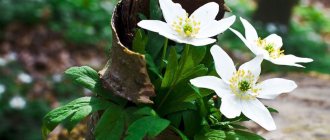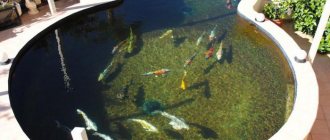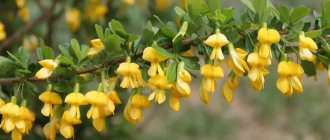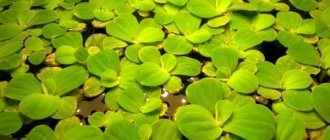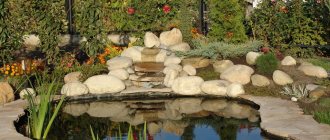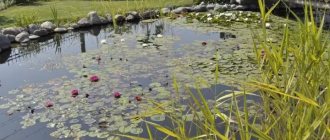Siberian marsh flower (Nymphaeum cotyfolia) - belongs to the Shifts (Menyanthaceae, from the Latin menyo - show, anthos - flower). Latin name: Nymphoides peltata. The basionym (the initial name of a taxon, which is replaced by another due to an adjustment in the position or rank of the taxon) of the name of the plant is Limnanthemum peltatum. The marsh flower has the following heterotypic synonymous names:
- Villarsia peltata;
- Nymphoides flava;
- Nymphoides natans;
- Limnanthemum nymphoides;
- Nymphoides orbiculata.
Biological taxonomy of the taxonomic ranks of the mireweed (Russian and Latin names):
| Domain (Regio) | Eukaryotes |
| Kingdom (Regnum) | Plants (Plantae) |
| Type (Phylum) (division) | Flowering plants (Angiospermae) |
| Class (Сlassis) | Dicotyledons (Magnoliopsida) |
| Squad (Ordo) (order) | Asterales |
| Family _ | Shift workers (Menyantháceae) |
| Genus _ | Swamp flower (Nymphoides) |
| Species _ | Nymphoides peltata |
— Advertising —
English names: yellow floating-heart, fringed water lily.
- 4.1 Chemical composition
- 6.1 Growing in the garden
Plants that purify water - oxygenators
“Urut spiky” PHOTO: www.ccwaterscapes.com “Bolotnik (Water Star)” PHOTO: www.flower-onego PHOTO: Mersiyanova I.
BUTTERCUPLE AQUATIC
TILLEA
OXYGENATOR PLANTS: MY EXPERIENCE
Plants - Oxygenators - these are plants that, in the process of their life activity, enrich water with oxygen.
“Brilliant pondweed” PHOTO: www.chelsad.ru
PHOTO: Pryanikova O.V.
Many times I took Elodea, Hornwort and Urut from natural reservoirs and planted them in my reservoir.
These plants are short-lived and after a couple of years they have to be replanted. “Water Buttercup” PHOTO: www.euro-plant.ru
The only plant that has taken root very well and has been growing for me for many years is Curly pondweed. Two plants, planted in different buckets and placed at a depth of 1.85 m, grow and bloom beautifully in summer. Hornwort also swims in small quantities. All other Plants - Oxygenators need to be restored periodically. Despite the presence of a waterfall that enriches the water with oxygen, I think there is a need for such plants. You can take them from natural reservoirs, since I have never seen them on sale.
I bought plants such as Pistia (Water Lettuce) and Eichornia (Water Hyacinth) and planted them in a pond more than once, but it was during these years that it was cold, the plants were small, did not grow well (Pistia) and did not bloom (Eichornia), and an attempt to preserve them in winter in an aquarium even with lighting and oxygen enrichment or in pots with soil in the refrigerator was not successful. I regret that I didn’t plant these plants in the hot summer of 2010 - I couldn’t find them.
Cattail, Frog Watercolor, Duckweed Trilobed and other Aquatic, Coastal and Marsh plants, although they do not belong to Oxygenator Plants in their pure form, absorb organic matter from water well, thereby increasing its transparency. Their excess can simply be removed from the reservoir with a fan rake into the compost.
Source
Water lilies
Roots in the bottom soil, leaves on the surface of the water, flowers on the surface or above the water. The genus Nymphaea includes many species and cultivars with flowers of various colors. They are not afraid of low air temperatures and can remain outdoors until freeze-up. Tropical water lilies are not suitable for growing in open water because they require positive night temperatures throughout the year. Helps maintain water clarity and protects water from overheating in summer. Depending on the type and variety, they are planted to a depth of 0.1-1 m, but most water lilies require a depth of 25-50 cm. Place in a sunny place in standing, calm water away from a fountain or waterfall.
NYMPHAEA Water lily, water lily
The water lily is the recognized queen among aquatic plants. Every owner of a garden pond either already has one or dreams of purchasing one. The plant is remarkable not only for its beautiful cup-shaped or star-shaped flowers, but also for its rounded or heart-shaped leaves, which protect the water from overheating and help keep it clean. This magnificent plant can surprise many and confuse beginners. First of all, the huge variety of sizes of the entire plant, its leaves and planting depth is striking. For a mini-pond built in a barrel, dwarf (miniature) water lilies with leaves up to 2.5 cm in diameter, covering an area of up to 1 m2, are suitable. On the other hand, some large water lilies have leaves up to 20 cm in diameter and can cover an area of 4 m2, and flowers are the size of a soup bowl. The golden rule when buying a water lily is not to buy the one you like from the photo or the cheapest one presented at the exhibition. First, measure the area of your pond and choose a plant that, when grown, will cover no more than half of it. And never be guided by price - large water lilies are cheaper, at first glance, less spectacular small ones, but are not at all suitable for a medium-sized pond. There are four types of water lilies - dwarf, small, medium and large. All you need to do is select a type of plant with a planting depth and expected growth area suitable for your conditions, and within this group, find a variety with the flower shape and color you like. Flowering time is not very important, since all water lilies bloom at approximately the same time - from June to September. The flower opens late in the morning, closes in the evening and lasts for about four days. Unfortunately, with the classification and names of varieties of water lilies, not everything is so simple and the same plant can be called differently on different farms. The classification proposed below is also very approximate. Another amazing fact about water lilies: most of the dozens of existing varieties appeared as a result of the breeding work of one person - the Frenchman M. Joseph Bory Latour-Marliac. He developed the first hybrid in 1877, but, unfortunately, with his death in 1911, all his secrets were lost. So almost all varieties offered in catalogs these days were bred more than 80 years ago! In recent years, new varieties of American selection have begun to appear, but Latour-Marliac hybrids still dominate the market. Now about how to plant water lilies. The best time for this is May-June. Planted in a sunny place in calm water. Old leaves are removed and fibrous roots are shortened. The plant is planted in such a way that the top of the rhizome is slightly above the soil level; the soil around the rhizome is thoroughly compacted. The basket with the plant is lowered to such a depth that the young leaves float on the surface of the water, and as the petioles lengthen and new leaves grow, they are gradually lowered to a greater depth. This may take several months. Leaf blades can rise above the water for several reasons. First, the pond may be too shallow. In addition, the plant may become too small and require replanting. This usually happens three to four years after planting. On the propagation of water lilies, see the article.
Plants for cleaning water bodies
The water features in the garden are beautiful and attract everyone's attention. And how much trouble arises with their appearance: cleaning, maintaining decoration, preserving for the winter. But there are some methods to make life easier for the owner of a reservoir.
What is a body of water purified by plants?
A pond, which can be cleaned with the help of plants, is a body of water divided into
- deep
(for example, for swimming), - shallow
water zones with plants that serve as natural water regenerators.
Such a pond has a natural appearance and fits perfectly into the landscape of a landscape garden.
Plants that purify the pond
Plants that “clean” a body of water are called bioplateaus
. They perform a huge number of functions in addition to the main one.
- The main filtration function is to promote the sedimentation of substances, for example, oxidative (during the process of photosynthesis, water is enriched with oxygen).
- The function of absorbing nutrients and some organic matter, as well as accumulating toxic substances and converting them into non-toxic compounds, is also important.
- In addition, plants in the bioplato are capable of accumulating some metals and organic substances that are difficult to decompose.
Bioplateau and biofiltration
- For water filtration, the optimal size of a bioplateau is about 2/3 of the reservoir.
- Therefore, the entire pond must have a sufficiently large area.
- Biofiltration is an almost ideal option for water purification.
- The water actually becomes crystal clear if the bioplateau is done correctly.
_____________________________________________________
It is not recommended to breed fish in such a reservoir, as this greatly increases the load on the regeneration zone. _____________________________________________________
What plants to use to clean a pond
Plants are oxygen generators
(enrich the water with oxygen) play an important role in maintaining the cleanliness of the pond.
- They should be placed in the deep part of the pond and trimmed regularly to prevent them from growing haphazardly.
- Plants taken from their natural habitat tolerate winter well.
- The species composition of vegetation must form a developed root system and be resistant to adverse factors.
Plant species most often used as bioplato:
- calamus;
- bisexual swampweed (water star);
- irises;
- marigold;
- water buttercup;
- pontaderia;
- curly pondweed;
- cattail;
- submerged hornwort;
- common telores;
- water urut;
- falaris reed;
- antipyretic fontinalis (key moss);
- plantain chastuha;
- Eichornia;
- elodea.
In a self-cleaning pond, everything is interconnected:
- water nourishes plants,
- plants purify water,
- dead representatives of the flora break down into microelements necessary for the growth of other microorganisms.
How to make a pond with cleansing plants?
- Plants from the regeneration zone consume huge amounts of nutrients, preventing algae from growing.
- The optimal height of the deep zone is 120–180 cm, for the regeneration zone – 40–80 cm.
- On average, in order to prevent water turbidity in a reservoir with a water surface area of 100 m², it is necessary to use about 17 coastal plants and about 20 to plant in the water.
- A mixed pond cleans itself without the use of chemicals.
Read even more articles on our website “Antonov Sad.ru”
Source
Oxygenating plants for a pond in the garden.
Swampweed (Callitriche). The plant is very useful for a pond, especially if it is inhabited by goldfish. The shoots die off in the winter. The downside of the swamp is his capriciousness. Propagated in spring and summer by cuttings.
Hornwort (Ceratophyllum). Not whimsical, grows both in the sun and in the shade. A plant without roots, planting comes down to the fact that the shoots are simply thrown into the water. At the end of summer, overwintering buds form at the ends of the branches, which sink to the bottom of the reservoir, from which new plants grow the next season.
Chara. It is rarely recommended to be placed in a pond, as it grows very quickly. Its only advantage is the ability to remove lime from a reservoir.
Swampweed, commonweed (Eleocharis). It grows quickly and forms at the bottom something similar to an underwater lawn. The swamp is more suitable for large bodies of water, not for small ones. Planted in a basket at the bottom of the pond in spring or summer.
Elodea. The growth of elodea is very difficult to control, so it is not suitable for small bodies of water, although it perfectly enriches the water with oxygen. Elodea is planted in small reservoirs only if other plants do not take root well in it.
Fontinalis. It grows slowly and prefers flowing water. Propagated by dividing the bush forever or in summer.
Turcha (Hottonia). One of the few blooming oxygenators. Peduncles rise above the water to a height of 25 cm. In autumn the leaves die off, and the plant overwinters at the bottom of the reservoir in the form of dormant buds. Propagated by cuttings in summer.
Urut (Myriophyllum). Suitable for a small pond. It blooms with reddish flowers that rise 2.5 cm above the water. Some species are not frost-resistant.
Pondweed (Potamogeton). Blooms, flowers rise above the water in early summer. The plant prefers running water.
Buttercup (Ranunculus). The plant dies after flowering. Propagation is carried out by cuttings in spring or summer.
Tillaea. Originally from Australia. The stems and fleshy leaves form a dense carpet on the surface of the water. Tillea grows very quickly. Reproduction is carried out in spring or summer.
Turcha
This oxygenator differs from many representatives of the group in its ability to bloom brightly. Turchi flowers appear on peduncles that grow up to 20-25 cm in height and rise above the surface of the water surface of the pond. White or pale purple flowers are at the very top of the peduncles.
The feathery leaves of the plant are bright green in color. In the fall they die off, and the turkish buds safely overwinter in the pond. The plant can be propagated by cuttings, which is best done in the summer.
Other oxygenating plants for a garden pond: swampweed, water buttercup, tillea, urut, hara, telores.
Remember that oxygenating plants are very useful for a pond, therefore, when organizing a pond on your site, do not forget to plant elodea, hornwort or water moss in it.
Oxygenators are primarily submerged plants that play an important role in keeping the pond clean. Rarely among them are species with beautiful leaves or flowers. But these plants are still needed, because... During photosynthesis, oxygenators absorb carbon dioxide and minerals from water and release oxygen. As a result, the algae are deprived of food, and the water in the pond can remain clean and clear longer. This helps to establish biological balance in the pond. Therefore, we can say that oxygenators are planted in a reservoir only for the purpose of water purification. The most popular oxygenating plants include elodea, swampweed, hornwort, turkish grass and water moss.
Swampweed (Callitriche)
Swampweed (Callitriche)
- small, tender plants with branched, rooting stems. Our ordinary locals. Their life span is indefinite, but they are always preserved - by seeds or vegetatively - in the same place. They can grow on land and in water. The ground form is creeping, with narrow leaves. In aquatic forms, the leaves are thin, light, linear and (or) with widened ends - spatulate.
The following types can be used in landscaping ponds:
| VIEW | DESCRIPTION |
| Common marshweed , or water star - Callitriche palustris | The most beautiful of all. When immersed in water, it develops on the surface neat, concave funnels - “stars” - from elliptical leaves crowded at the tops of the shoots. When shallow waters dry out, it forms a terrestrial form. |
This annual plant forms dense thickets of tender shoots from 3 to 20 cm long, on which opposite leaves are located along the entire length. In the water column, the leaves are narrow, linear, with long internodes. At the top of the shoot, the internodes are greatly shortened, and the leaves have a spatulate shape and form a rosette. It is this rosette, and not the tiny, almost imperceptible flowers located in the axils of the leaves, that give the plant a decorative appearance.
Location:
They prefer to grow in stagnant or slowly flowing water, but can also live in waterlogged soil - damp hollows and periodically flooded areas.
Landing:
Planted either directly into the soil of a reservoir or placed there in a container. When planted shallowly (up to 10-20 cm), good “stars” develop. If deeper (up to 50 cm), they may not come to the surface. The place is sunny or partial shade. Any soil.
Swamp plants can be transferred to the created pond from a natural reservoir (taking a small part of the bush so as not to damage the mother plant). Transplanted specimens must be carefully inspected and washed to avoid introducing unwanted insect larvae or snails. Planting plants in a pond is not difficult; just tie several shoots together, tie a stone to their base and lower them into the water. Overgrown plants can be thinned out using a net or fan rake.
Care
does not require. Not aggressive and doesn't bother anyone. It may unnecessarily shade the surface, in which case it needs thinning. Winter-hardy.
Reproduction occurs on its own - pieces of shoots take root easily. The swampweed reproduces by individual shoots, part of a bush, and also by seeds.
Usage:
for decorating ponds of any size. Marshmen will be at home in any body of water, but they look especially beautiful in small ponds, where you can admire them up close. They not only decorate and enliven the pond, but also purify the water and provide shelter for numerous aquatic life, which helps to establish ecological balance in the pond.
Urut (Myriophyllum)
Urut (Myriophyllum)
- perennial underwater plants of the family. Slanoberry-bearing, with a shoot rising to the surface of the water. Long flexible stems are covered with pinnate leaves with very thin lobes. The branched stems of the uruti cling to the oars and are often torn off. The plant has a creeping rhizome, from which new leafy shoots quickly grow. The leaves are green or brownish.
The Latin name comes from the merger of two words: miros - countless, phyllum - leaf. Indeed, the long (up to 150 cm) stems of uruti with leaves deeply dissected into thread-like lobes form a thick lace of underwater thickets in the water. Thanks to these numerous delicate leaves, the plant received the name “pinnate”, and the Germans call it “yarrow”.
Of the several types of uruti, widely distributed around the globe, two grow in central Russia: urut spica
(M. spicatum) and
urut verticillatum
(M verticillatum). Other species are not frost-resistant.
Coastal
Our services: selection of plants and pond design/ planting of plants/ landscaping of coastlines
Cabomba is an underwater plant that actively releases oxygen.
Price: 350 rubles
Elodea is a perennial plant. Grows well in standing or slow-moving water. Completely submerged in water. Grows strongly in any conditions.
Price: 350 rubles.
Hornwort is an unpretentious plant that has no roots. Does not tolerate sunlight. Adapts to any conditions. Releases oxygen and purifies water. Planted at a depth of up to 9 m.
Price: 350 rubles.
Cirrus is an elegant plant with a long, wide stem. Actively saturates water with oxygen, absorbing carbon dioxide, and serves as food for fish. Excellent dense cover for fry.
Price: 350 rubles.
Spreading
The plant has not yet bloomed.
The plant prefers slow-moving rivers, lakes, reservoirs and ponds, and also grows in wet mud, swamps and wetlands, ditches, canals, waterways and dam "breach" basins.
Nymphaeum thymus grows in Europe, Asia, Transcaucasia, India, Korea, China, Japan, Mongolia, and Iran.
The plant is included in the Red Books of such countries as Russia, Ukraine, Belarus, Latvia, Lithuania.
Elodea
This aquatic plant is also known as “water plague”. This is because it grows very quickly. However, Elodea's ability to purify water significantly overshadows this drawback. The plant is easily recognized by its long, bright green shoots with small lanceolate leaves and white flowers that appear in the summer.
Elodea prefers stagnant water and a temperature of about 20°C. Since the plant can live at a depth of 20 cm to 3 m, it can be planted both in coastal areas and in deep water. Elodea does not require special care, except that it needs to be thinned out periodically.
Landscape planning
Landscape planning is a whole Universe of knowledge about plants, architecture, design, construction, etc. This knowledge cannot be neglected because...
| Today | 85 | |
| Yesterday | 540 | |
| 2020-03-28″ /> | this week | 2352 |
| 2020-03-22″ /> | Last week | 2574 |
| 2020-03-28″ /> | For this month | 9087 |
| 2020-03-01″ /> | Last month | 8491 |
| Total | 546881 |
Practical benefits of plants for a pond
It doesn’t matter what size the country pond is. A mini-pond will decorate a small garden; on a larger plot, a man-made lake will look picturesque. To design the water surface and shores, you will need natural materials: sand, stones, pebbles. But in order to give an artificial reservoir the most natural look possible, you cannot do without aquatic and coastal plants.
A deserted water mirror surrounded by the same shore looks boring. Aquatic plants for a pond are not only an opportunity to show your imagination and turn a plastic container dug into the ground into a pearl of the garden. The decorative purpose is important, but if you choose the right flora, you can also solve important practical problems:
- Saturate the water with oxygen, create a habitat suitable for aquatic fauna (fish, snails).
With an emphasis on cereals Source yandex.net
- Maintain the ecosystem by preventing mud from growing and helping the water stay clean.
- Protect the water column from excessive penetration of ultraviolet radiation.
Therefore, pond plants are conventionally divided into two groups: ornamental crops and health plants. The former are distinguished by their spectacular appearance, large floating leaves and bright flowers. These include water hyacinths, lilies, and lotuses. The latter are not so impressive, but without them it is impossible to maintain the health of the reservoir. The water remains clear thanks to swampweed, hornwort, and elodea.
With a waterfall Source diz-cafe.com
Capricorn
The entry of the Sun into the sign of Capricorn coincides in Europe with the estimated time of the birth of Christ. This fact in European culture is associated with the beginning of the new year.
Capricorn - the highest point of the Zodiac, its zenith - is associated with the highest stone mountain peak on Earth, from where the entire planet is visible, as well as with the highest manifestations of a person who has received divine wisdom.
The Rocks of Capricorn represent the solid state of the barren Earth, its energy is dense, hard, focused.
The earth in the cardinal cross expresses the exaggerated properties of the elements: inhibition, petrification, stopping of life processes, crystallization. The dryness of the elements is expressed in perseverance, unevenness, rigidity, reaching the point of ossification in this sign, and Cold symbolizes the rational character of Capricorn, expressed in the desire to strengthen, cool, hold, and subjugate the surrounding world.
The earth of the spiritual level in the Zodiac governs the phase of construction of the common Good, which comes after mastering the thought creativity and wisdom of Sagittarius. To build the common Good means to be an assistant to the Creator in creating the world. Looking at the history of human development, we notice that all great cultures were built on the foundation of religion and Testaments. The worldview acquired in Sagittarius in Capricorn takes on specific forms of religions and philosophies, sciences, colored by the time and character of peoples.
The construction of the universal Good is based on the dynamic balance of two world forces - evolution and involution, and this is not a repeating flat circle rotating in place, but a spiral unfolded into infinity, the turns of which are never repeated, but are always similar to each other. Here the embodiment of the harmonious severity of the elements is subject to the universal law of the ideal level, perceived in the external order (cardinal cross) of the structure of the Universe. Thus, the construction of the Universe is based on a cosmic system that expresses the idea of the Supreme Spirit, the worldview of the manufacturer.
Number 10
Sign. Feminine, earthy, cardinal.
Managers. Saturn and retrograde Uranus.
Exaltation. Mars and retrograde Pluto.
Exil. Moon.
Fall. Jupiter and retrograde Neptune.
Constitution. Asthenic. Narrow shoulders, weak, undeveloped chest. Long thin neck. Rough facial features. The face is oblong, thin, wrinkled. The nose is long, the chin is strong, sharp, narrow, cheekbones are pronounced, eyebrows are often protruding forward, thick, lips are thin, tightly pressed to each other. Undeveloped earlobes. Sparse, thin hair and beard, most often dark. The posture is quite rigid, the gait is sedentary.
Temperament. Phlegmatic, with a strong tinge of pessimism.
Positive traits of character and disposition. Purposefulness, perseverance, endurance, endurance, restraint, self-control, self-control, pronounced ambition, pride, independence, independence, hard work, efficiency, diligence.
Negative character traits. Selfishness, greed, self-will, waywardness, lust for power, abuse of power, deceit, distrust, cruelty, stinginess, dissatisfaction with oneself, dependence on mood.
Weak points of the body and body. Knee joints, bones, skeleton, ligaments, tendons, digestive tract, liver, gall bladder, spleen, pancreas, skin, teeth.
Diseases. The above mentioned organs and body parts. Metabolic diseases, bone fractures, dislocations of limbs. Gout, rheumatism, skin diseases, atherosclerosis, gall and bladder stones, colds.
In childhood, Capricorns have rather poor health, worse than other signs, but the strength of their resistance increases with age. Capricorn's sober, calculating nature gives him amazing endurance, but nevertheless he does not always manage to avoid doctors and hospitals, because... they are crippled by fear, uncertainty and worry more than germs. Even their conservative habits and stubbornness, their resistance to illness cannot overcome the dangers of pessimism. Capricorns need to spend a lot of time outdoors and develop a more positive and easy-going outlook on life. Almost all Capricorns have sensitive skin. This manifests itself in all kinds of allergies, excessive sweating and other skin diseases. Stomach diseases are also possible; joints and bones are vulnerable areas. The fruits of their melancholy can be headaches, kidney disease and mental illness. If they manage to avoid long-term illness due to their depression, then their ability to live long is amazing. Well, I don’t know, is it good to be the last leaf on the tree and at the same time suffer from arthritis and rheumatism?
Decorating a pond with aquatic plants
Decorating a pond with aquatic plants
In order to decorate a pond with aquatic plants, you must first decide on the following questions:
- Will the plants be able to survive the winter (and the method of planting the plants will depend on this: in containers or in the soil).
- Which plants to choose: deep-sea, oxygen generators, embankments or floating
- When and how to plant aquatic plants
- Requirements for planting
- Which representatives of aquatic plants should be preferred?
Not only the overall decorative appearance of the pond, but also its durability and ability to support the livelihoods of fish will depend on all these issues. Next, we will consider all these issues in detail.
Swampman
The plant looks like green cushions located at the bottom of the pond, from which rosettes of leaves floating on the surface extend. In summer, small flowers can be seen on the swamp grass. But they do not have any decorative value; green rosettes of brightly colored leaves look much more impressive in the water.
Swampweed is an annual small plant 5-20 cm long. It likes to grow in slowly flowing or standing water, so it is ideal for an artificial pond. Swampweed is usually planted in shallow water or in a swampy area. When placing a plant in a pond, it is important to provide it with sunny or partial shade. Marshweed is an ideal aquatic species for small bodies of water.
Lythrum virgatum
It is native to Eastern Europe, Western and Central Asia, and Northwestern China.
Unlike its more common relative, L. salicaria, it has a more bare stem, it is lower, the inflorescences are not as dense, and the flowers are smaller. Common loosestrife in the pond of the Garden. Photo by the author This is a thicket perennial up to 90 cm high and 45 cm wide. The leaves are linear-lanceolate, glabrous, 10 cm long. The flowers are star-shaped purple-red, purple-pink, 1 cm in diameter, collected in slender spike-shaped racemes up to 30 cm high, bloom from the beginning to the end of summer. It has decorative varieties that are even more spectacular than the original form: 'Rose Queen' (up to 60 cm high, pink-purple flowers) and 'The Rocket' (up to 80 cm high, dark pink flowers).
Features of care and reproduction
Since they do not differ from the corresponding characteristics of loosestrife, see the article on the website: Flowering time of loosestrife.
Basic landing rules
- It is recommended to plant plants in ponds after the pond has been filled with water and has settled for at least 10-14 days. The optimal time of year is late spring, early summer. Depending on which variety is chosen, they are planted at the bottom of the reservoir or along the shore. And don’t forget about the rule that each sprout must be placed in a flower pot.
- Why are holes needed in baskets? A small addition. Each pot should have holes in the bottom and walls for good ventilation. Otherwise, the roots will begin to rot. By the way, caring for such plants will be much easier. For the winter, you can move them to a warm room.
- What soil to use for landscaping a pond with plants? It could be soil mixed with clay or bone meal. It is better to immediately forget about fertilizers such as manure, black soil and peat. They can provoke poisoning of fish, frogs and other inhabitants of the reservoir.
- How to avoid soil being washed out of pots? After planting, a coarse fabric (for example, burlap) is laid on top and sprinkled with small pebbles.
- How to prepare plants for planting? Regardless of which type was chosen, it is recommended to remove old and yellowed leaves, as well as long roots.
- How to survive the winter? In summer, the plants will begin to grow abundantly, so they need to be thinned out from time to time. Old shoots are removed. Aquatic crops that are accustomed to a temperate climate can be left in the pond of a summer cottage for the winter.
Bathhouse combined with a pond: convenient and beautiful
You can bring to life the original idea of combining a natural pond with a bathhouse. The fact is that not everyone likes to swim surrounded by fish and aquatic plants, and combining a pond and a swimming pool is an excellent solution to the problem.
To do this, two concrete walls 20 centimeters thick are laid along the pond, which divide the pond into four parts. A swimming path, free of plants, will form in the middle, and on the sides water lilies and egg capsules will bloom in riotous colors, behind them the banks can be decorated with dwarf cattails and swimsuits. Looking at this wonderful structure from the side, you would never guess that a luxurious bathhouse is hidden in the very center. In the area where they rise from the water, wide wooden walkways are installed where the whole family can sunbathe or where garden furniture can be placed. The concrete walls are buried 40 centimeters below the water level.
For better waterproofing, use a thick film that covers the entire bottom of the pond, the dividing walls and the path between them. A 10-centimeter layer of sand is placed at the bottom of the pond where the plants are located, then covered with burlap and pond soil mixed with garden soil is added on top. Some fast-growing plants are planted in special containers, and some are simply planted in the ground. The bottom of the bathing path is covered with sand on top of the film, and on top with special rolled pebbles.
Hornwort
The perennial plant is quite common in the middle zone. Hornwort has long stems that branch at the top. The leaves are dissected narrow threads. The plant is suitable for deep-sea zones and can grow even at depths of up to 9 m.
Hornwort will thrive in both shade and sun, but it does not like too much light. The plant can overwinter directly in a pond: its upper part dies off, and the buds sink to the bottom.
Lily is the most popular pond plant
One of the most popular plants in decorative ponds is considered to be the water lily. People often call it a water lily. Refers to deep-sea plants, the rhizome grows horizontally. In nature, there are four types of water lilies, which differ in size, flower diameter, and coverage area.
Oddly enough, larger flowers are often several times cheaper than small and inconspicuous plants. However, the first type is exotic and grows only in tropical latitudes, and does not adapt well to ours.
The first leaves of the plant begin to appear as soon as the ice melts. Flowering lasts until late autumn, peaking in July-August. When purchasing water lilies for ponds in a store, take into account such characteristics as the temperature of the pond, the depth of your pond, and its area. For example, if the pond is small, abundant flowering of lilies can greatly shade it. This will cause swamp gas to appear and the water will begin to rot.
After 2-3 months, the deep-sea lily is transplanted to greater depths. Externally, the marsh flower is very similar to the water lily. Its leaves are small and have wavy spots (5 cm in diameter).
Wintering water lilies (video)
Since we are talking about lilies and marsh flowers, we cannot help but recall another plant from the deep-sea family, which is used in private ponds. This is a water lily, which is considered a full relative of the water lily. Its flowers are small, located on thick peduncles and rise slightly above the water level. A small, dwarf egg-pod is recommended for a pond in a country house.
Yellow capsule and water lily are the most common inhabitants of reservoirs in the country
Biological action
The marsh flower rose above the lake.
The marsh flower is used as a tonic. The plant also has antiparasitic, diuretic, and antipyretic effects. Nymphaeum is able to stimulate lactation in women. Fresh leaves are used to treat recurrent headaches (migraines, neuralgia). Nymphaeum is used to treat burns, fever, ulcers, snake bites and swelling.
Pondweed floating
This perennial, like many oxygenating plants, not only enriches the water with oxygen, but also provides a haven for fish. Place the plant in the deepest part of the pond, where it is immersed in a container or planted directly into the ground, pressing the cuttings with a weight.
Pondweed grows well in the sun, but it can also be kept in partial shade. The oval leaves of the elongated shoots of the plant are on the surface, and individual parts can come off and float freely on the surface of the pond. The only problem with floating pondweed is that its growth is extremely difficult to limit.
Story
Photo of the bog flower
The bog flower was first named Menyanthes nymphoides by Linnaeus in 1753. In 1770 S.G. Gmel renamed the plant Limnanthemum peltatum. In 1891 the name was revised to its current recognized scientific name, Nymphoides peltata.
Conferva
Fontinalis, as this plant is also called, grows quite slowly compared to most oxygenators. Nevertheless, in terms of cleansing functions, it is not inferior to other plants in the group.
Water moss thrives in sun and partial shade. It is recommended to plant the plant in a pond with fish, because they lay eggs on the thin long stems of fontinalis. The leaves of the plant are dark green and elongated. Water moss can be propagated by dividing the bush, which is best done in spring or summer.
Briefly about the main thing
A pond in the garden is not only water and stones; Plants become an important decorative detail. They help to fit an artificial reservoir into the landscape and perform other functions: they purify the water, protect it from sunlight and saturate it with oxygen.
Plants are planted in zones, taking into account their characteristics. Oxygenating plants are natural purifiers; they are entirely hidden in the water column. Floating species make the surface of the pond picturesque; hydratophytes with their large and bright flowers become the highlight of the landscape. Plants in the coastal zone should be selected especially carefully, taking into account their size and moisture-loving properties.
Source
Coastal species
In the coastal zone, dechampsia and calamus, marigold and sedge are most often planted. The latter is mainly used in large bodies of water (protruding sedge). An excellent choice would be Pontederia cordate, the inflorescences of which have an unusual pale blue hue and a spike-like shape.
Pontederia cordate
Of course, these are not all types of plants for ponds - we have listed those that are most often used by summer residents and landscape designers. We also looked at the main groups and the most important aspects that should guide your choice. Arrange the pond to your liking and share your photos!
